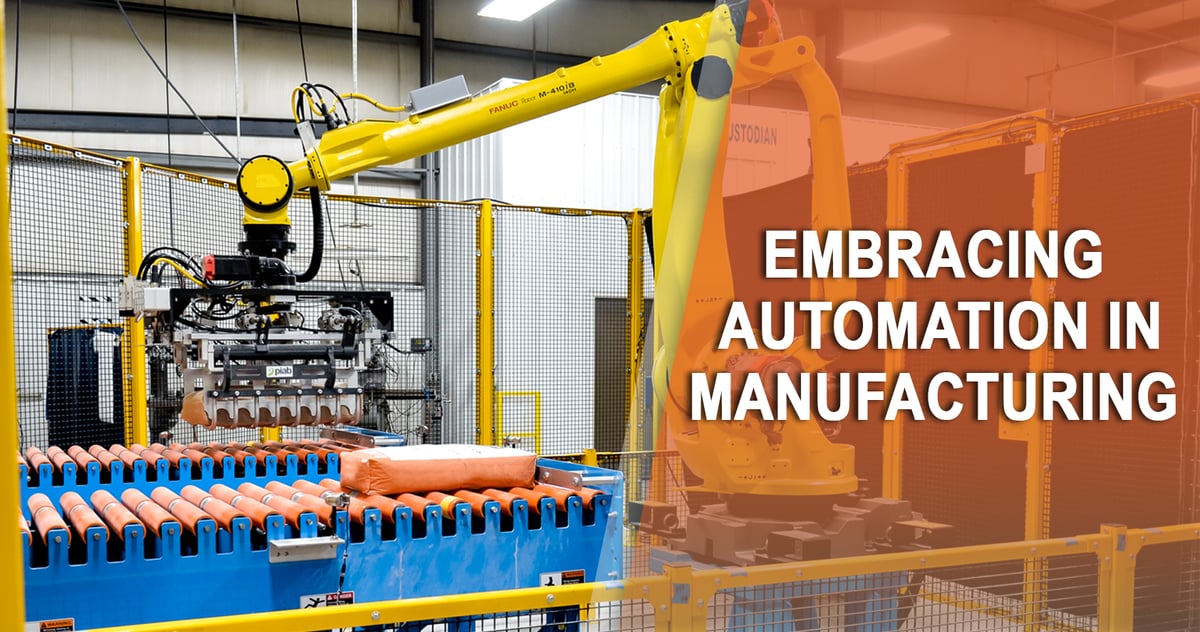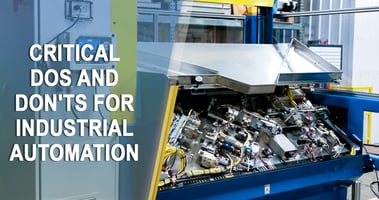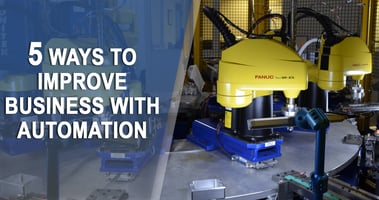As consumers evolve, so do their expectations for manufactured goods. This evolution—among other...
Making the Case for Automation in Manufacturing

The historical realities of the manufacturing industry paint a vivid picture of assembly line workers moving products in rote cadence. Many of us conjure images of nondescript factory employees in identical hard hats and protective gear manually turning the metaphorical cogs that keep a giant production wheel in continuous motion.
Over the last several decades, however, the evolution of manufacturing automation has transformed once difficult, slow, and hazardous production tasks into remarkably safer and more productive ones. Even so, many organizations still cling to traditional (and often outdated) methods throughout their daily operations.
As automation in manufacturing continues to advance in sophistication, so do the advantages of leveraging such opportunities in facilities across the industry. Although the prospect of adopting a modernized and unfamiliar approach to routine operations can seem daunting to players in the decision-making arena, the payoffs are well worth the leap.
Here are some of the most eye-opening insights about automation in manufacturing that emphatically support the case for integration within your organization.
Which Manufacturing Companies are Ripe for Automation?
As organizational leaders consider the best avenues for hitting production goals, optimizing efficiency, minimizing waste and mitigating risk, they’re tasked with examining a myriad of factors. When it comes to automation, many wonder whether modernizing in this way is realistically suited to their particular brand of operations—or best left to other types of manufacturing processes.
To help clarify this question for you and your leadership team, here is a list of relevant applications for integrating automation in the manufacturing process:
- Material handling
- Material removal
- Assembly and/or welding
- Material dispensing
- Painting
- Welding
Manufacturing automation has been embraced by manufacturers in a range of industries, including utilities and infrastructure, pharma, healthcare, food and beverage, consumer products, and automobile. It comprises both fixed automation and robotics systems, both of which are suited to varying purposes and production needs.
The way in which your company ultimately chooses to leverage automation should depend largely on your business goals and operational requirements, but regardless, the opportunities for organizational benefit are immense.
What are the Distinct Upshots to Embracing Automation in Manufacturing?
As you analyze and discuss the potential for adopting one or more elements of automation at your manufacturing facility, there’s an array of advantages to highlight along the decision-making process. The most valuable comes in the form of significant cost savings derived from factors such as:
- Improved Quality: The elevated precision of fixed automation and especially robotics systems affords you the capability to improve production quality and accuracy. This also leads to a decrease in scrap or waste, which is an additional avenue for cost savings.
- Reduced Labor: Automation naturally minimizes the need for manpower, which cuts down on the major expense of employee hours. Particularly at a time when labor shortages are prevalent, minimal reliance on human interaction is a considerable benefit.
- Worker Retention: Many manufacturing processes involve a certain number of unfavorable, high-risk jobs for which worker retention is a huge expense. Automation lessens or, in some cases, eliminates the need for humans to perform these types of tasks, therefore cultivating a more amenable work environment—an important key to achieving less turnover.
- Consistency of Throughput: Human workers are just that—human. This means their energy and focus tend to ebb as they tire near the end of a shift. Automation puts a profitable stop to this cycle of waning productivity.
- Risk Mitigation: The decreased human interaction that accompanies manufacturing automation inherently minimizes workplace injury risks that can cost your company in dollars spent on workers’ compensation, increased insurance premiums, and potential compliance fines.
- Global Competitiveness: Manufacturing your product locally, where it is purchased, gives you a huge competitive advantage in supply chain management, particularly during a global pandemic. Automation enables manufacturers to keep production onshore, giving U.S. companies a competitive edge in the global market.
Given the wide span and nature of opportunities for deriving value from automation, it can be argued that just about any manufacturing operation has the potential to benefit from embracing it. This is especially true for those that:
- Operate in a labor-intensive manufacturing industry
- Function in undesirable and hazardous environments (e.g., foundries, where the conditions are particularly rough)
- Comprise areas with close quarters, like meat-packing and food-processing facilities (remember: machines and robots don’t get sick!)
It should also be noted that 15-20 years ago, automation was simply too expensive for smaller companies (under $20M) to implement, but this has completely changed over time. Now, automation is suited to organizations of all sizes. As long as you’re seeking to lower cost and improve efficiency, automation is worth your consideration.
What Automation Outcomes Have Real-Life Companies Achieved?
For an even more concrete look at the advantages of adopting automation in manufacturing, here are some examples of actual companies—real Wauseon Machine clients, in fact—that have realized enormous gains from automating elements of their process.
A small chemical company based out of northeast Ohio was involved in building skids of mortar. Their bag sizes went up to 80 pounds, and they needed to complete eight of these bags per minute. At the time, this required three workers performing the job during each of three shifts per day.
By partnering with Wauseon Machine to automate this process, they have been able to completely eliminate the need for associated man hours. Whereas they once faced high worker turnover, a significant injury rate and inconsistent quality, they now reap the benefits of cost savings and risk mitigation, which has had a tremendously positive impact on their bottom line.
Another manufacturer, which was outsourcing the assembly of a product component, employed a manual process that saw a scrap rate of over 30%. Over a 24-month period, their volume needs doubled, providing a new challenge to meeting production goals.
Eventually, they decided to bring the product component in-house and worked with Wauseon Machine to automate the process. As a result, they were able to meet their production gains and even contain the scrap rate to under 1%.
Another great example is a company palletizing bags of livestock feed. Although most bags today weigh less than 50 pounds, bag sizes change frequently so the company needed to accommodate accordingly.
For organizations like this (ones requiring a more fluid manufacturing process), robotics provide the opportunity to accommodate changes and also repurpose automation solutions for fluctuating needs. Robots can be programmed to perform multiple functions for products of varying sizes and materials. In this case, a robotics approach implemented by Wauseon Machine supported the flexibility of the automation to shift palletizing based on bag size.
These are just a few examples of how automation has enabled manufacturing companies to reach new heights. Simply put, automation is no longer the wave of the future; it’s a present-day reality and completely within reach. For organizations focused on efficiency, profitability and growth, automation is the clear and smart path forward.
Have more questions about how automation can be leveraged to fortify your manufacturing business? Download 4 Tips to Ensure a Successful Robotics Integration in Manufacturing to gain critical insights on maximizing automation ROI in your facility.



